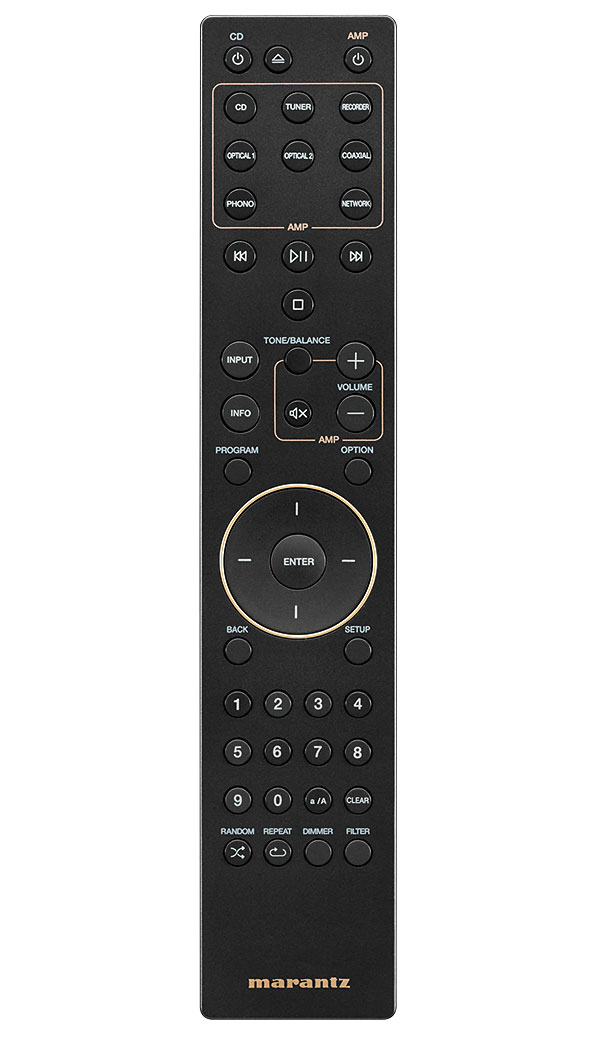Marantz CD 60 CD Player/DAC Page 2
![]() Authentic Audio
Authentic Audio
For this model, Marantz is using an ESS ES9016K2M DAC rather than its own MMM DAC solution – you'll have to head over to the three-times-the-price SACD 30n for that. Any digital 'features' are necessarily limited, but it is worth investigating the two filters on offer. The Filter 1 option is supposed to be the closest to the 'traditional' Marantz sound, while Filter 2 is a bit snappier in terms of bass.
If the absence of standard digital inputs gives the impression that the CD 60 is a stripped-down player then this is not exactly true of the internal engineering, and of the analogue stage in particular. This employs a version of the brand's familiar, discrete HDAM op-amp, not least because this proprietary circuit gives its designers the flexibility to fine-tune Marantz products to their liking.

It certainly contributes to the CD 60 sounding 'authentically Marantz', whether from CD or file, and over speakers or headphones. There's a smooth, organic feeling to its performance, and the sense that all musical elements are being treated with equal care. Górecki's 'Symphony No. 3 Op. 36' (aka 'Symphony Of Sorrowful Songs'), as performed by Beth Gibbons and the Polish National Radio Symphony Orchestra [Domino WIGCD395X], is a powerful and melancholic work, and the CD 60 gave it an excellent rendition.
The performance of Gibbons, also known as the sultry lead singer of trip-hop pioneer Portishead, had a real vocal richness, and the orchestra sounded expansive. I tested the CD 60 with a compact Primare I15 amplifier [HFN Oct '18] and Canton Reference 7K floorstanding loudspeakers [HFN May '22], and it was certainly noticeable what this disc-spinner was bringing to the table with its added warmth and impressive stereo imaging.
The quality of the CD 60's audio 'tuning' was also clear when connecting a headphone to its front-panel output. Not every enthusiast will use this feature, preferring a standalone solution, but listening with Sennheiser HD 650s to the third movement of the Górecki symphony, I appreciated the CD 60's ability to drive these rather difficult headphones. And with the headphone output getting its own HDAM-SA2 amplifier stage, that smooth and slightly warm Marantz character did nothing to diminish the edge or sparkle of the musical event. The CD 60 scores further points for providing no fewer than three headphone amp gain settings – a feature that is typically absent from most disc players.
Going Solo
Marking Philip Glass's recent 85th birthday – apparently composing minimalist neoclassical music is good for your health – with his sparse, dreamlike Solo Piano set [CBS MK45576], the CD 60 did a very fine job at presenting the playing in the five 'Metamorphosis' pieces. The insight was detailed but not clinical and while there was perhaps the suggestion of a roll-off softening the highest harmonics, nothing could impede the sense of fluency. Indeed, some of the piano runs were positively 'organic', sounding like a waterfall or a babbling stream. If this is music that, when casually heard, may come across as mundane, then the CD 60 will surely grab your interest with its rich and enveloping delivery, encouraging a long and rewarding listen.

I'm not especially tempted to indulge in a like-for-like comparison with the recent Rotel DT-6000 CD player/DAC transport [HFN Aug '22], because it's far more expensive, but one of the discs I played heavily on that machine, Radiohead's Kid A [Parlophone 7243 5 27753 2 3] was still in the pile when I set up the CD 60. It's an interesting exercise to listen to the same CD on two very different players. Straight from the opening dense synths on 'Everything In Its Right Place', the CD 60 might have softened the overall impact, but still created a massive, immersive soundstage from which Thom Yorke's voice stood out without sounding disconnected.
This landmark turn of the millennium album saw the band changing tack – and not to everyone's liking – by embracing even darker themes and electronic experimentation. But unlike many techno tracks that feature attention-grabbing samples, the songs on Kid A leverage their effects to paint a grander picture. And this is exactly what Marantz's CD 60 manages to do, so much so that this album and player are close to the proverbial match made in heaven.
Hi-Fi News Verdict
For Model 40n owners looking to revive their CD collection, the CD 60 is a bit of a no-brainer. It has exactly – and only – the functionality you require, including a finely tuned DAC and output stage, and mirrors the design of Marantz's amplifier. But that's not the full story. Regardless of partnering kit, the luxurious CD 60 has broad appeal as an above-average, but still affordable, silver disc spinner.
























































